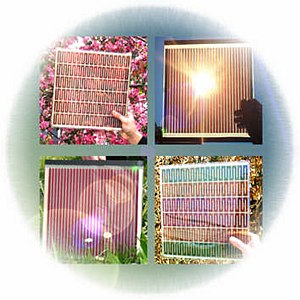
Back خلية شمسية صبغية Arabic Cèl·lula Grätzel Catalan Grätzelův článek Czech Grätzel-Zelle German Grätzel-sunĉelo Esperanto Celda Solar Graetzel Spanish سلولهای خورشیدی رنگحساس Persian Cellule solaire à pigment photosensible French תא סולארי מרוגש צבע HE Sel surya tersensitisasi pewarna ID

A dye-sensitized solar cell (DSSC, DSC, DYSC[1] or Grätzel cell) is a low-cost solar cell belonging to the group of thin film solar cells.[2] It is based on a semiconductor formed between a photo-sensitized anode and an electrolyte, a photoelectrochemical system. The modern version of a dye solar cell, also known as the Grätzel cell, was originally co-invented in 1988 by Brian O'Regan and Michael Grätzel at UC Berkeley[3] and this work was later developed by the aforementioned scientists at the École Polytechnique Fédérale de Lausanne (EPFL) until the publication of the first high efficiency DSSC in 1991.[4] Michael Grätzel has been awarded the 2010 Millennium Technology Prize for this invention.[5]
The DSSC has a number of attractive features; it is simple to make using conventional roll-printing techniques, is semi-flexible and semi-transparent which offers a variety of uses not applicable to glass-based systems, and most of the materials used are low-cost. In practice it has proven difficult to eliminate a number of expensive materials, notably platinum and ruthenium, and the liquid electrolyte presents a serious challenge to making a cell suitable for use in all weather. Although its conversion efficiency is less than the best thin-film cells, in theory its price/performance ratio should be good enough to allow them to compete with fossil fuel electrical generation by achieving grid parity. Commercial applications, which were held up due to chemical stability problems,[6] had been forecast in the European Union Photovoltaic Roadmap to significantly contribute to renewable electricity generation by 2020.
- ^ Wan, Haiying "Dye Sensitized Solar Cells", University of Alabama Department of Chemistry, p. 3, published 2004.
- ^ "Dye-Sensitized vs. Thin Film Solar Cells", European Institute for Energy Research, 30 June 2006
- ^ EarlyHistory Archived 28 March 2016 at the Wayback Machine. Workspace.imperial.ac.uk. Retrieved on 30 May 2013.
- ^ O'Regan, Brian; Grätzel, Michael (1991). "A low-cost, high-efficiency solar cell based on dye-sensitized colloidal TiO2 films". Nature. 353 (6346): 737–40. Bibcode:1991Natur.353..737O. doi:10.1038/353737a0. S2CID 4340159.
- ^ Professor Grätzel wins the 2010 millennium technology grand prize for dye-sensitized solar cells, Technology Academy Finland, 14 June 2010.
- ^ Tributsch, H (2004). "Dye sensitization solar cells: A critical assessment of the learning curve". Coordination Chemistry Reviews. 248 (13–14): 1511–30. doi:10.1016/j.ccr.2004.05.030.
© MMXXIII Rich X Search. We shall prevail. All rights reserved. Rich X Search